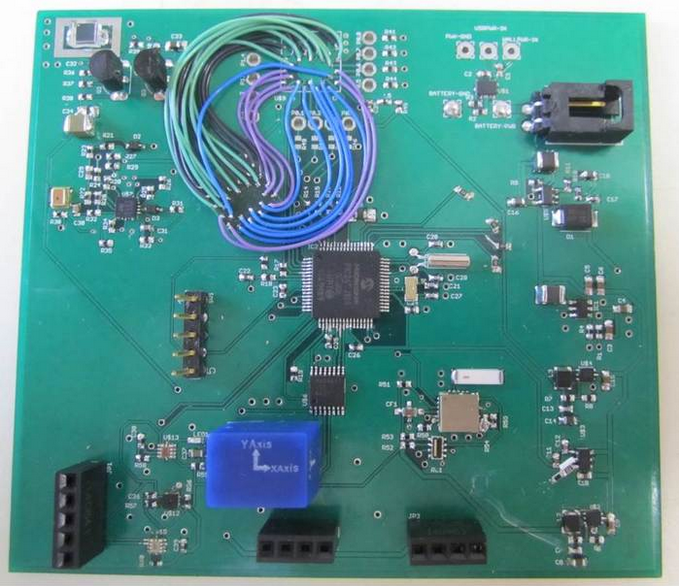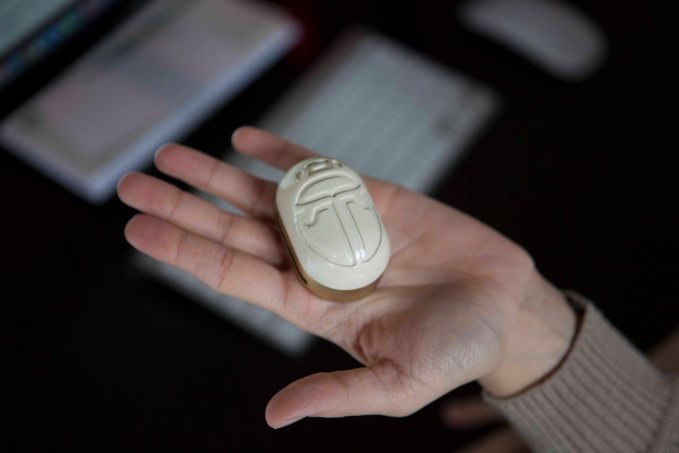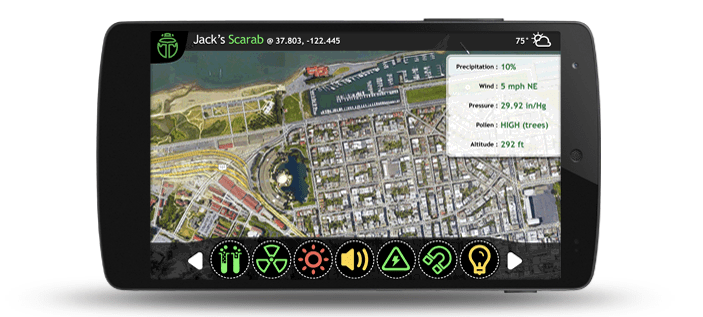Smartphones are steadily gaining sensors and senses. Location positioning and accelerometers are standard issue now, while higher end mobile devices might also include more specialist sensors that can tell you your blood oxygen saturation or measure UV exposure.
There’s no reason to think this sensory expansion will stop. But with smartphone roadmaps generally structured around yearly refresh cycles there’s a (shrinking) window of opportunity for smaller players to push in offering auxiliary sensing hardware — before our pocket computers get there en masse.
The latest hopeful aiming to nose in is called Scarab. It’s currently raising crowdfunding on Kickstarter — passing its $100,000 goal with support from a small group of backers (~330), with about a week left of its campaign to run — for an environment sensing device that’s designed to be worn somewhere on your person where it comes into contact with the elements, such as on a backpack or belt.
Scarab’s U.S.-based makers plan to cram a full 16 sensors into what they intend to be a compact wearable. So more sensors than you’d get in even a high end smartphone, or in other dedicated environmental monitoring devices (such as the indoor-focused Alima or CubeSensors devices), as well as some more outlandish types of sensors, such as a gamma detector. More outlandish than you’d find in the average smartphone, certainly, though we’ve seen auxiliary dosimeter radiation sensors for phones before.
The idea of offering so many sensors within a single device is firstly to appeal to quantification nerds, but also to open up the potential for cross-referencing such a concert of data points to perform some interesting correlation analysis about the environments in which Scarab is moving through.
Their Kickstarter sales pitch focuses on helping people avoid personal health risks posed by ‘hidden’ dangers such as pollution. But CEO Scott Huyette sees potential for various use-cases for Scarab and the data the team hopes to generate, such as offering detailed noise pollution maps — which he says might be helpful to real-estate agents or house buyers. Or offering granular local data to municipal authorities who are monitoring urban environments and making city planning decisions.
The team is intending to license a mapping service so that the data harvested by Scarab will be displayed to users on a map view within the companion app (with data offloaded from the wearable to the mobile via Bluetooth LE). “So not only are you getting alerts if your personal sensors go off, but the community in the area will be providing updates,” he notes.
It will also be augmenting the data its hardware collects with publicly available data and displaying that on the map too — such as weather, pollen counts, surf conditions and so on.
The full list of planned sensors for Scarab is as follows:
- UV index sensor
- carbon monoxide detector
- gamma detector
- noise level detection circuit
- three axis magnetic field sensor
- liquid petroleum gas detector
- nitrogen dioxide detector
- ozone detector
- thermometer
- ambient light sensor
- relative humidity sensor
- digital output barometer
- gyroscope
- 3D magnetometer
- 3D accelerometer
- GPS module
The intention is for all these sensors to be housed in the Scarab wearable, which they’re aiming to shrink to perhaps an inch square — although it’s worth stressing they are on where near that point yet. Development work is at a very early stage, even for a Kickstarter project. And battery life will be an inevitable pain-point, with the device likely needing to charged daily.
As well as the hardware, Scarab’s team is planning an SDK so third party developers can build apps that tap into all the intel its multi-sensor wearable will be gathering — assuming they get the thing built, and convince enough quantification nerds to buy it.
Their current dev board (pictured below) is 3.7 inches x 3.4 inches — and below that are some photos of the current mock ups for the two planned designs of the finished product — so there’s clearly an awful lot of shrinking to do. Add to that they do not yet have a working prototype, although Huyette says that’s coming shortly and the team will begin capability testing of the individual sensors.



They’ll also need to be able to demonstrate decent sensing accuracy, post-shrinkage. So really this is mostly an idea and a design mock up at this point.
Isn’t it a bit early for the team to be crowdfunding? Huyette, who was an early backer of the Pebble smartwatch, says the intention is to involve future Scarab users in the product’s development “journey”.
“Kickstarter’s super interesting. I’ve enjoyed watching it involved. I was, in my last capacity as a venture capitalist, we were one of the first angel investors in Pebble, and that really opened my eyes to Kickstarter. I think Kickstarter is very much about the journey and lots of backers love that. And being part of the journey to a finished product,” he says.
“I think we could have waited a little bit longer [before doing the Kickstarter campaign] but at the time I believed we had enough to get people interested and to launch the campaign.”
“This project has to get done quickly. There are related products out there to Scarab. None have as many sensors, or have the whole platform approach. But there’s definitely interested parties from big guys like Motorola, to academic institutions,” he adds, discussing the shrinking window of opportunity for this type of standalone sensor.
“The Array of Things is a project that the university of Chicago is running in conjunction with Argonne National Labs, and a design school, and that is to put sensors like mine — but much larger — all over the city of Chicago to gather that data. There is an endless number of home smart devices. But getting it down at this size and for the consumer, it is I believe an evolutionary thing, not a revolutionary thing, so speed is of the essence.”
Huyette also touts the engineering pedigree of the team he has assembled to build Scarab, but does concede they do not have experience building consumer tech — so that’s another challenge to getting this wearable to market.
“They’re very skilled at communications, satellite, mobile, antenna, and they’ve executed all parts of this in different projects before. This is a lot of sensors on a single platform — I think that’s a differentiator, and I’m hopeful that the public is interested in that, but… I wouldn’t say this idea is unique so it needs to get executed very quickly,” he adds.
“Roughly eight of our sensors are now, let’s say common in the high end smartphones… and then the other half are sensors that the general public doesn’t have access to typically — but might be found in industry or in meteorological settings so we think that will be a whole new realm of data at the hyper local level. Because we aim to be taking measurements will all the sensors about every 100 meters that you travel. We think this will be providing weather conditions at a level that isn’t currently seen anywhere.”
The initial business here is selling the sensory hardware itself — Scarab is being priced from $129 to early Kickstarter backers — but the longer term play would be about blossoming into a big data business. Assuming it can get enough Scarabs out there taking measurements. (We’ve seen others try to build out large-scale usage communities to glean comprehensive data-sets, such as the Air Quality Egg, but scaling usage is absolutely a work of years — unless you’re giving away the sensing devices for free. So that grand vision will be difficult to achieve in a standalone specialist product like this.)
“If we take 16 sensor impressions every 100 meters that you travel during the day, or on a time-base if you’re not traveling, I think we start to aggregate a lot of data very quickly,” says Huyette.
Quickly, perhaps. But patchily, certainly. However he still sees value from the data Scarab will be able to gather, no matter how many users it has — pointing to sunscreen purchases as one example where Scarab’s intelligence gathering might become useful to a general consumer (or to the makers of other products).
“At the end of the summer, no matter how many users that I have, I’ll be able to show UV exposure on a cumulative basis for the whole summer. Even academic and science institutions don’t have that kind of data on a local basis, on a per user basis,” he says, adding: “That’s the kind of data we need to tackle large problems like skin cancer.”
The team’s delivery roadmap is to ship Scarab to general backers by August. Huyette concedes this is “challenging” — so, if you’re thinking of taking a punt on this hardware startup, it’s prudent to factor in some delays, as is ever the case with Kickstarter projects (and especially those involving hardware).
“We’re hoping for delivery in the August timeframe. I think it’s challenging. We think we have a large scale manufacturing partner, they have a huge amount of competencies in sourcing and design and manufacture and delivery etc. That’s a big component of it,” he says.
“I built the timeline off of consultations with my engineers, and their experience. We think it’s doable but yeah, timelines are aggressive,” he adds. “Right now we’re on that timeline, and that’s our goal. Some Kickstarter projects have been subject to delays… and some deliver on time. I want to be in the portion of Kickstarter projects that deliver on time. That’s a reputation thing, so we’re working very hard to make sure we’re on that timeline.”
